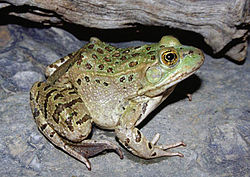| Chiricahua leopard frog | |
|---|---|
 | |
| Scientific classification | |
| Domain: | Eukaryota |
| Kingdom: | Animalia |
| Phylum: | Chordata |
| Class: | Amphibia |
| Order: | Anura |
| Family: | Ranidae |
| Genus: | Lithobates |
| Species: | L. chiricahuensis |
| Binomial name | |
| Lithobates chiricahuensis Platz & Mecham, 1979 | |
| Synonyms | |
| |
The Chiricahua leopard frog (Lithobates chiricahuensis syn. Rana chiricahuensis) [3] is a species of frog in the family Ranidae, the true frogs.

